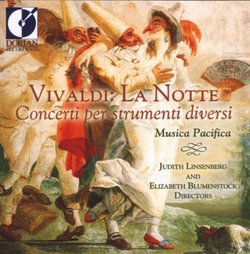| All Artists: Musica Pacifica, Linsenberg, Blumenstock Title: Vivaldi: La Notte (Concerti per strumenti diversi) Members Wishing: 0 Total Copies: 0 Label: Dorian Recordings Release Date: 5/13/2003 Genre: Classical Styles: Chamber Music, Forms & Genres, Concertos, Historical Periods, Baroque (c.1600-1750), Classical (c.1770-1830), Instruments, Strings Number of Discs: 1 SwapaCD Credits: 1 UPC: 053479325228 |
Search - Musica Pacifica, Linsenberg, Blumenstock :: Vivaldi: La Notte (Concerti per strumenti diversi)
 | Musica Pacifica, Linsenberg, Blumenstock Vivaldi: La Notte (Concerti per strumenti diversi) Genre: Classical |
Larger Image |
CD Details |
CD ReviewsIncendiary Vivaldi Giordano Bruno | Wherever I am, I am. | 06/30/2008 (5 out of 5 stars) "Another barn-burner performance from Musica Pacifica! I've given five-star reviews to three CDs from this California-based ensemble now, so I decided to listen to La Notte head-to-head with other recordings of the same concerti, particularly the fine CD by recorderist Dan Laurin with the Drottningholm Baroque Ensemble. Musica Pacifica comes out ahead in several ways. The balance of the upper voices with the continuo forces is better. The continuo is more shapely in phrasing and more transparent. The recorder playing of Judith Linsenberg is more expressive in phrasing and more incendiary in the fastest passages. To be fair, Laurin is perfection itself in tuning, while Linsenberg occasionally 'colors' sustained notes a bit more than I prefer. The bottom line is that this is one of the most satisfying performances of Vivaldi's chamber concerti available. "Continuo" refers to the continuous series of chordal notes in the bass parts of Baroque and Rococo music, upon which the melodic upper voices are composed. "Continuo" is also used to mean the instruments that play those fundamental notes. Musica Pacifica uses cello, archlute, and harpsichord, often all three together, for its tasty continuo. Sometimes Vivaldi builds his variations on an ostinato basso - ostinato being the Italian for "obstinate" - a continuously repeating musical phrase which may be as simple as six long notes in a zig-zag phrase. Another sort of continuo is a steady progression of notes to be "figured" or elaborated by the chordal instruments, rather like the 'walking bass' of traditional jazz. Vivaldi is very good at enlivening both sorts of continuo with surprises, as you'll hear on this CD. Bassoonist Marilyn Boenau joins Musica Pacifica on five of the concerti recorded here, as does oboist Gonzalo Ruiz. The oboe's role in this performance is literally to play "second fiddle" to the recorder, which Ruiz does with aplomb. The bassoon, on the other hand, ranges through the music from sharing continuo chores with the cello to taking the melodic lead in tandem with the recorder or elaborating angular countermelodies to the suave cantabile passages of the recorder. Boenau handles her historical bassoon deftly and expressively. It's amazing, for anyone who has ever played the little wooden flute called the recorder, to hear what character a virtuosic player can coax out of one. The recorder has a narrow range, limited dynamics, and very slight variation of tonal color; its virtues are its responsiveness to fast-flying fingers and its capacity for liquid phrasing. Linsenberg's phrasing, on the legato and largo movements of these pieces, are like wind-carved sculptures in a Baroque fountain, and her fast passages approach "warp speed" on the Starship Pacifica. Violinist Elizabeth Blumenstock gets her chance to take front-stage on the gracious early Vivaldi Sonata in C Major, which she plays pensively and with charming restraint. Otherwise this CD belongs to the recorder and the bassoon, and since I'm a recorderist/bassoonist myself, I can't imagine a more proper state of affairs." Vivaldi:La Notte (Concerti per strumenti diversi) William F. Drum, Jr. | Piedmont, CA USA | 01/11/2007 (5 out of 5 stars) "This CD was all that I expected. It offered at least the quality of performance and repoduction as any of my other 24 Vivaldi CDs. All but one of the pieces were new to my collection. I assume this is because these are infrequently performed. Nonetheless, these compositions were alltogether as interesting as Vivaldi's other works. Musica Pacifica,Judith Linsenberg,and Elizabeth Blumenstock remain true to the Baroque forms in style and interpretation. I have no regrets from this purchase." I use this CD to get in a great mood. anonymous | CA | 12/15/2009 (5 out of 5 stars) "The music on this CD always puts me in a great mood. Not only is the music wonderful, but Musica Pacifica's performance is excellent throughout. The ensemble plays very well together, with lovely tones throughout. Concerto in G minor, RV 107 is particularly beautiful."
|
